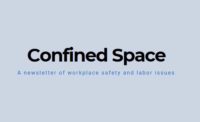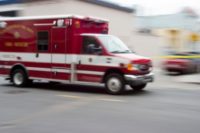A Confined Space blog post
Indiana OSHA cuts penalty 94% for fatality at Indiana auto parts facility
Posted with permission from Confined Space, a newsletter of workplace safety and labor issues.
Last October, Melissa Stephens went to work on third shift at Autonium in Jeffersonville, Indiana. She never came home to her husband of 20 years or her four children. Stephens had apparently gone through the interlocked gate, to put a fiber pad over a broken seal. But a spinning belt and pully dragged her into a machine where she was crushed to death.
Unexpected tragedy? Freak accident? None of the above. In fact, another Autoneum worker, Kasi Ballew, had been dragged into the same machine just a year before. Ballew was nine months pregnant when
| Someone is going to end up being killed on this machine. |
“I told several people, someone is going to end up being killed on this machine and unfortunately it, it happened,” Ballew told WAVE 3 News.
Indiana OSHA (IOSHA) found that:
- Employees wore loose clothing and other items that could be drawn into machines.
- Machines had pulleys and belts that exposed employees to hazards.
- Employees weren’t properly trained to shut down machines in case of an emergency.
IOSHA fined Autoneum $224,000 for Stephen’s death.
No amount of money will ever make up for the loss of a wife and mother, but the $224,000 fine was still a relatively high penalty for OSHA, and especially for the state of Indiana, which has a low average penalty level compared with the other 20 states that run their own OSHA program and that the state had not yet increased it penalty levels by 80% as Congress had mandated the year before. Two violations were classified as “serious,” and three of the violations, totaling $210,000, were considered “knowing,” which is the same as a “willful” penalty from federal OSHA. Two of the willfuls were for machine guarding violations (failure to properly guard pulleys that were 7 feet or less from the floor or work area; and failure to properly guard rotating belts from employees) and one was for failure to “lock out” the machine while it was being repaired.
But that’s where the “good” news ends. Last December, Indiana OSHA quietly cut the penalty over 94% — from $224,000 to $14,000 because "some of the violations either weren’t valid or weren’t as serious as originally believed.” One serious violation and two willful violations were eliminated, and the third willful was reduced to a $7,000 “serious” penalty.
Autonium is a Swiss-owned auto parts company that makes parts for companies like GM and Ford. This wasn’t the first time company was fined by OSHA. Last May, Autoneum’s Toledo, Ohio, plant was cited $569,463 for violations following the amputation of an employee’s hand, wrist and part of his forearm, less than a year after the facility received citations for similar hazards. Included in the citation were three “willful violations,” which means the company was aware of them, and two repeated violations. All of the violations were similar to the violations originally cited at the company’s Indiana plant a few months later.
According to the settlement, Autoneum only agreed to retrain their employees on lockout procedures and to post signs warning employees where the machine can’t be completely locked out. The settlement also stated that nothing in the settlement “shall be deemed admission by the Employer of the allegations contained in the within the Safety Order(s) and Notification(s) of Penalty.”
Following Stephen’s death, Autoneum stated that
Note that they never actually apologized. “Deeply affected” is not quite the same as “incredibly sorry.” Nor does the statement that “Autoneum complies with occupational health and safety regulations at all locations worldwide” pass the laugh test. The same Ohio Autoneum plant had previously received several smaller OSHA citations, as had plants in Pennsylvania and South Carolina.
What’s Wrong With Indiana OSHA?
Now, I have no idea what went into the final settlement, but clearly something is wrong with Indiana OSHA. Either the original inspection and citation of the plant was woefully problematic, or the state performed one of the biggest cave-ins in OSHA history.
Indiana OSHA, unfortunately, has a long history of serious problems. In 2016, its average penalty for a serious violation was only 45% of federal OSHA’s average penalty. Furthermore, although state plans are required to increase their penalties in accordance with a law passed by Congress in 2015, Indiana has not yet done so. Consequently, its maximum penalty for a serious violation is only $7,000 per violation while the federal penalty is $12,934 per violation. The federal maximum for a willful citation is now $129,336 per violation, while Indiana’s remains at $70,000.
OSHA’s most recent annual report showed that the state was struggling with staffing and had conducted only 796 inspections in FY 2015, well below its planned number of 1,212. In the early 2000’s, the state routinely conducted around 2,000 inspections a year.
In 2014, when current Vice President Mike Pence was Governor, federal OSHA issued a “scathing” 19-page report on the operation of Indiana’s program, in response to complaints about Indiana’s program. Among the findings were:
- IOSHA failed to initiate inspections in a timely manner and inspections weren’t conducted in accordance with written procedures. I-OSHA failed to conduct inspections, including after an explosion at Indiana Power and Light in March 2013. IOSHA also took four times longer than allowed to initiate inspections and had a backlog of nearly 100 unprocessed complaints, some up to six weeks old.
- IOSHA failed to conduct an effective whistleblower program. Among other issues, procedures were not followed and the state set an impossibly short deadline for completing whistleblower investigations. Consequently, employers simply stalled until the time period had passed.
- The state did not document the reasons for safety orders, penalties or deletion of penalties when they reached informal settlements.
- Short time frames were set for inspectors to complete investigations, leaving insufficient time for them to adequately address and document serious hazards, and for industrial hygienists to schedule and conduct noise or chemical sampling of workers. Inspectors also didn’t have time to conduct complex or large establishment inspections, or to expand inspections when additional hazards were identified in the course of an inspection.
It was unclear how seriously IOSHA took the report:
Reaching settlements with companies, and reducing penalties is common. OSHA has an incentive to reach a settlement because companies are not required to fix hazards until the case is final, and reaching a settlement will often avoid years of legal action while workers remain unprotected. But it’s almost unheard of that a penalty will be reduced this much — especially in a fatality case. In addition, but removing all of the willful citations, it also makes it impossible for OSHA to pursue criminal penalties. The law states that OSHA can only pursue criminal penalties when the agency has issued a willful citation related to a fatality.
So what was the problem with the Jeffersonville inspection? Clearly there were major problems at the plant before Stephens was killed, as Kasi Ballew and others described. And clearly Autoneum managers knew about the uncontrolled hazards.
It’s possible the company convinced OSHA that “worker error” caused the fatality. Stephens was apparently wearing loose clothing and may have bypassed an interlock that was supposed to shut down the machine. We have discussed a number of times the problems with blaming workers for incidents. In a similar fatality at an auto parts facility in Alabama. Regina Elsea went around the interlock to fix a machine and was impaled when the machine started up as she was repairing it. Managers initially blamed Elsea for violating company rules until video tape and testimony showed that bypassing the interlocks was a common occurrence that was not only observed, but encouraged by management.
Will OSHA Ensure That State Plans Are “At Least As Effective” as Federal OSHA
The Occupational Safety and Health Act requires federal OSHA to ensure that the states conduct programs that are “at least as effective” as federal OSHA’s. The question facing the Trump administration is to what extent federal OSHA will use the limited tools it has to ensure that workers in the 21 state plans states (and the five public employee only states) received the same or better protections than employees in federal states.
One of the first items on the Obama administration’s OSHA agenda in 2009 was to ensure that state plans were “at least as effective as” the federal program as the law requires. At that time, Nevada OSHA was facing serious problems after a series of fatalities on a major construction job on the Las Vegas strip. In 2009, OSHA launched a special study of the Nevada program which found serious deficiencies. OSHA went on to take a closer look at all of the other state programs and launched a number of initiatives to ensure that they were operating in a manner at least as effective as the federal program. OSHA was also forced to confront Arizona which refused to update its residential fall protection requirements, South Carolina which proposed to eliminate its whistleblower program and Hawaii, which required help to reconstruct its program after a previous Governor had catastrophically underfunded the program. OSHA also ordered state plans to adopt National Emphasis Programs and struggled — with mixed success — to ensure that state plans’ lower penalty levels were increased to approximate the level of federal OSHA penalties.
We’re continuing to see problems with state programs in the Trump administration. Maryland, for example, has not yet adopted OSHA’s new silica standard and is the only state that has not even begun the process. Last May, OSHA sent a letter to Arizona OSHA warning the state that it was following inappropriate enforcement procedures. And many states, like Indiana, have still not adopted OSHA’s new penalty structure, meaning that state penalties will lag further and further behind federal OSHA’s. It is not yet clear to what extent federal OSHA will push states like Indiana, Maryland and Arizona to comply with the law.
Workers, unions and others have the right to file a Complaint Against a State Program Administration when they feel that a state is not in compliance with “at least as effective as” criteria. I expect we’ll be seeing more of those, and I’m looking forward to seeing how federal OSHA responds.
Click here to visit Confined Space.
Click here to donate to Confined Space.
Looking for a reprint of this article?
From high-res PDFs to custom plaques, order your copy today!





